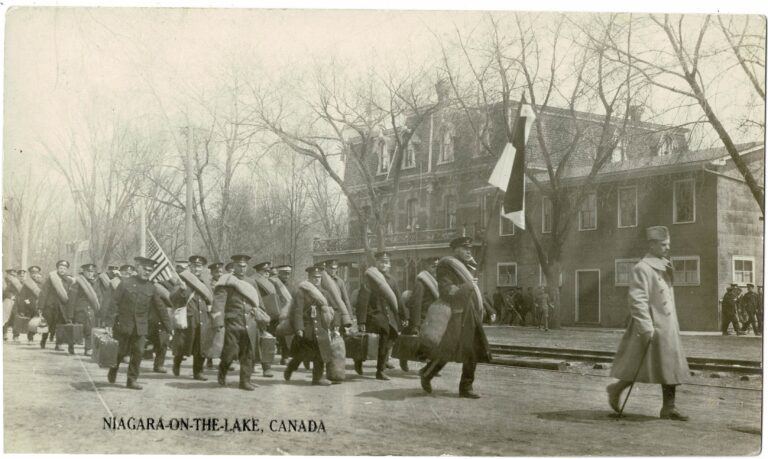
Exploring History: The bun gets it done!
Janet didn’t just preserve history — she made it. Now, in 2025, the NOTL Museum is channelling the spirit of Janet and her iconic bun as it celebrates 130 years of getting things done.

Janet didn’t just preserve history — she made it. Now, in 2025, the NOTL Museum is channelling the spirit of Janet and her iconic bun as it celebrates 130 years of getting things done.

Janet Carnochan was a local powerhouse of a woman who worked as a teacher for 45 years and became the Niagara Historical Society’s first president. Janet, along with her board, opened Memorial Hall on June 4, 1907.

People have been fishing Lake Ontario and the Niagara River for as long as humans have inhabited these shores. The river, lake and creeks once had an abundance of fish, which allowed humans to develop an important relationship with our waterfront.

This week’s photo shows the former lawn bowling green at the corner of Johnson and Regent streets in the Old Town district of Niagara-on-the-Lake. The lawn bowling club began in 1877 and moved from this location to its new home at the Community Centre in 2011.

This 1955 political cartoon highlights the issues that were top of mind for then Lord Mayor William Greaves Jr. during his tenure. It seems he was in a real “jam” that year.

It’s a historical collection covering several decades of Niagara-on-the-Lake’s early days, includes hundreds of artifacts and details the life and times of one of Upper Canada’s most influential Loyalist families — a family whose fingerprints are all over the history of this town.

Historians believe that the town and part of the township may have been briefly named after Charles Lennox, an important member of the British government at the time.

The Queenston-Chippawa Hydro-Electric Plant was the first true mega hydroelectric project and the largest hydroelectric power station of its kind in the world.

This grand, two-storey estate that overlooked the Niagara River was an important and rare example of a Classic (Greek) Revival house in a picturesque setting in Ontario. Built in 1832, it was only seven years shy of hitting its 200-year-old anniversary.

In celebration of Easter, many residents of Niagara-on-the-Lake would send homemade greeting cards to their friends and family.

In the 1930s, there were a series of photographs taken of Queen Street for insurance purposes. The buildings in this photo still exist today, save for the original firehall, which burned down in November 2009.

During elections for the first parliament of the province of Canada, Edward C. Campbell won by one vote against Henry J. Boulton — Boulton appealed the election results, and the seat was turned over to him after a year.

It was around this time that the Niagara Parks Commission pushed tourists to visit Queenston Heights for the picturesque views rather than the site’s history. This “attraction” likely came about to encourage people to take home a souvenir as a reminder of their visit.

It wasn’t until 1964 that a “boom” was placed in the upper part of the river, near Lake Erie, to limit the flow of ice sheets that, when pushed by the wind, can create ice accumulation up to 12 feet thick.

Niagara-on-the-Lake has an interesting history in connection with Ireland. In fact, we had a whole section known as “Irish Town.” Many Irish immigrants settled here following their arrival in 1847 during the Irish Famine.

This one-and-a-half-storey clapboard house was built by John Wilson in 1816. It was part of the rebuilding that took place here following the burning of Niagara in December 1813.

Over 20,000 Polish Americans were trained here to support the work of the Allies. The Polish saw the war as an opportunity to reclaim Poland, which had been partitioned by several Axis powers beginning in 1795.

The Coloured Corps fought in several battles during the War of 1812. In the early months of 1814, they were assigned to serve as a company of artificers — soldiers who performed engineering and construction duties, including on Fort Mississauga.

This week’s image shows a classic Valentine from the 1900s. Unfortunately, finding Valentines from the 1820s can be tricky. We have included the image to help showcase a beautiful poem by Eliza Henry,

The month of February is for celebrating Black history! This week we learn about local businessman Lewis Ross, who had a barbershop on Queen Street.

In this week’s edition of Exploring History, the NOTL Museum highlights an undated pencil sketch shows a couple taking a sleigh ride in the winter weather.

The future King George V and Queen Mary made their royal visit to Canada in 1901, arriving in Niagara-on-the-Lake the evening of Oct. 12 and spending the night at the Queen’s Royal Hotel.

The Niagara Township Credit Union was created in 1945 with 18 members and total assets of $24, to fill the need for banking services in the growing community.

This local department store was founded in 1867. The family-run business was such a success that they eventually opened another location in Virgil.

This detailed work shows a celebration within the camp with bright lights and soldiers in formation. The painting was created by Sir Edmund Wyly Grier.

© All Rights Reserved, Niagara Now.

